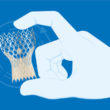Cardiac failure (CF) and sudden cardiac death (SCD) stand out as two of the main causes of death in patients with aortic stenosis. Although transcatheter aortic valve intervention has shown higher survival, these two continue to be the main conditions leading to patient death at followup. In its early days, TAVR also showed benefits, but...
TAVR in Asymptomatic or Minimally Symptomatic Patients: 30-Day Results
Aortic valve replacement (AVR) is recommended for symptomatic aortic stenosis (AS), while close monitoring is the advised strategy for asymptomatic patients, unless they have elevated aortic gradients, reduced ejection fraction, or abnormal stress tests. However, the optimal timing for AVR remains uncertain, especially in light of recent evidence suggesting that AS patients showing signs of...
Predictors and Evolution of Need for PPM after TAVR with Self-Expanding Valves
In the context of TAVR, one of the current challenges is the need for permanent pacemaker implantation (PPM), especially when using self-expanding valves (SEV). The information available in this regard remains controversial; while some studies suggest new PPM implantation will have no significant effect on clinical evolution, others have associated them with worse prognosis. As...
Predictors and Evolution of Permanent Pacemaker After TAVR with Self-Expanding Valves
Transcatheter aortic valve replacement (TAVR) has shown remarkable benefits and continues to advance towards lower-risk patients and younger ages. However, one of its limitations lies in the demand for a permanent pacemaker (PPM), which during TAVR early stages with self-expanding valves reached 30%. Uncertainty persists regarding the evolution of patients undergoing PPM implantation after TAVR,...
SOLACI-SBHCI 2023 | TAVR – Lifetime Management of Patients with Aortic Stenosis – Dr. Ole de Backer
Read the most outstanding articles from SOLACI-SBHCI 2023 Congress. In this case, check the presentation by Dr. Ole de Backer, entitled “TAVR – Lifetime Management of Patients with Aortic Stenosis”
TAVR Durability at 5 Years in Intermediate Risk Patients
TAVR has been shown beneficial in patients across the risk spectrum. The PARTNER 2 SAPIEN 3 (P2S3i) study on intermediate risk patients was the first to show TAVR superiority vs SAVR when using the transfemoral approach. SAVR durability has been shown in different analysis but, except for a few reports, TAVR durability at long term...
Aortic Stenosis and Cardiogenic Shock: Is TAVR an Option?
Cardiogenic shock (CS) in a setting of aortic stenosis is associated with high mortality rates. In consequence, surgery is generally not a possibility for this patient group, and they usually undergo aortic valvuloplasty, resulting in a mortality rate of 33%-50% at 30 days, 70% at one year, and 90% at two years. While transcatheter aortic...
VASC-OBSERVANT II Substudy: Impact of Vascular Complications after TAVR
At present, transcatheter aortic valve replacement (TAVR) has become increasingly common to treat severe symptomatic aortic stenosis, with the transfemoral approach being the most common access strategy, associated to better outcomes vs. other access sites. Even though vascular complication rates (VC) have dropped given increased operation experience and improved devices, such as the use of...
TAVR: Does HALT Affect Follow-Up?
Transcatheter aortic valve replacement (TAVR) in low-risk patients has been shown to be superior or noninferior in randomized studies, but the presence of valvular thrombosis, in its different forms, has not been well analyzed, nor is there much information on its impact on evolution. Researchers conducted an analysis of the LTR study that included 200...
Impact of Right Ventricular Pacing in Patients with Permanent Pacemaker Implantation after TAVR
Permanent pacemaker implantation (PPI) is a relevant complication in patients undergoing transcatheter aortic valve replacement (TAVR) despite there being new devices. The current information on the long term impact of this complication remains unclear and recent evidence suggests post-TAVR ventricular pacing (VP) might be associated to higher risk of all-cause mortality and hospitalization for cardiac...






